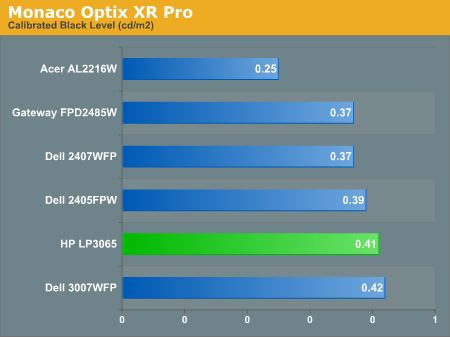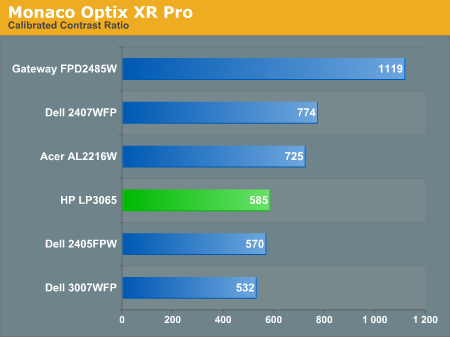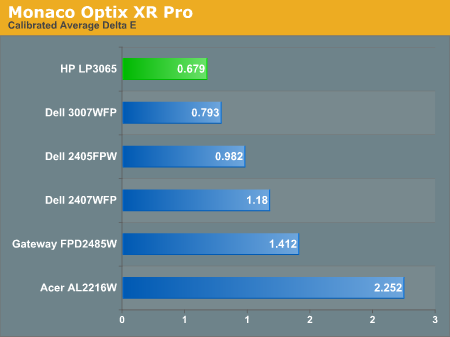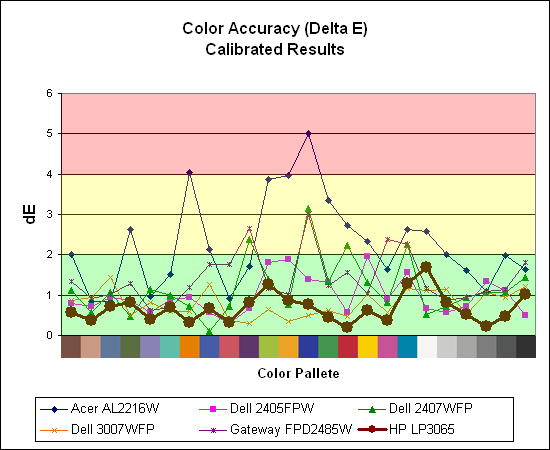HP LP3065: A new contender for the 30" throne
by Jarred Walton on March 22, 2007 7:00 AM EST- Posted in
- Displays
Calibrated Results
Brightness and Contrast Ratio
While a lot of people may never use a properly calibrated monitor, image professionals definitely need accurate colors. Here, we report scores for the same areas as we did on the previous page, only this time the results are taken after we have used Monaco Optix XR to calibrate the display.



The most significant changes from calibration come in the area of brightness, where all of the displays end up running at less than their maximum brightness. You can of course choose to run a display of a higher than recommended brightness level, and the ambient lighting in a room will also determine what brightness setting is best. Our testing was performed indoors with a moderate amount of lighting, and the displays were adjusted accordingly.
Color Accuracy


The uncalibrated results for color accuracy were generally mediocre at best for most of these displays, and only the Acer AL2216W came anywhere near a "good" rating. After calibration, however, the tables are turned: the Acer hardly improves at all, while all of the other displays improved substantially. The 30" displays and the HP LP3065 in particular do very well once properly calibrated. We just wish the displays were able to approach a reasonable level of color accuracy prior to calibration.
Brightness and Contrast Ratio
While a lot of people may never use a properly calibrated monitor, image professionals definitely need accurate colors. Here, we report scores for the same areas as we did on the previous page, only this time the results are taken after we have used Monaco Optix XR to calibrate the display.



The most significant changes from calibration come in the area of brightness, where all of the displays end up running at less than their maximum brightness. You can of course choose to run a display of a higher than recommended brightness level, and the ambient lighting in a room will also determine what brightness setting is best. Our testing was performed indoors with a moderate amount of lighting, and the displays were adjusted accordingly.
Color Accuracy


The uncalibrated results for color accuracy were generally mediocre at best for most of these displays, and only the Acer AL2216W came anywhere near a "good" rating. After calibration, however, the tables are turned: the Acer hardly improves at all, while all of the other displays improved substantially. The 30" displays and the HP LP3065 in particular do very well once properly calibrated. We just wish the displays were able to approach a reasonable level of color accuracy prior to calibration.










44 Comments
View All Comments
gfisher - Sunday, July 26, 2009 - link
My HP machine has an NVIDIA 8500GT graphics card. I'm interested in buying a HP LP 3065 thirty inch monitor. Will the card drive the monitor at full speed?DaveJDSP - Sunday, December 30, 2007 - link
Jarred,I cannot possibly thank you enough for testing and posting photos of viewing angles. When doing critical photo/graphics work, it is essential that the top and bottom of the screen appear consistent from a fixed viewing point in the center of the screen. The larger the monitor, the more critical this becomes, as from a fixed point, the eyes scan over an arc of 10-20 degrees or greater.
Most monitors that I have seen at local stores have viewing angles that are totally unsatisfactory for critical work, even from a fixed eye point. And there are very few local stores that carry a sufficient selection of better and larger monitors, suitable for more critical work, so that the buyer can evaluate those monitors in person. Therefore, your complete and comprehensive reviews become even more critical.
Thank you again for your excellent reviews and for including such critical viewing angle information.
Dave
chakarov - Friday, March 23, 2007 - link
Contrast by specification shoud be 1000:1 but you measured it 585:1.It is interesting what to believe.
JarredWalton - Saturday, March 24, 2007 - link
As I explained in the Gateway FPD2485W review, contrast ratios, brightness levels, response times, and various other "spec sheet items" are often seriously exaggerated. While technically a higher contrast ratio is better, a 500:1 or higher real value is generally more than sufficient. There's also a possibility that at some specific setting the HP would come closer to 1000:1 - doubtful, given the results on the three tested settings (uncalibrated, calibrated, and print calibrated), but still possible.The basic issue is with backlight bleed - i.e. blacks that aren't actually black. In theory, any proper display would have an infinite contrast ratio, as black would be 0 and anything divided by zero is infinity/undefined. Some displays (the Acer, for example) achieve higher contrast ratios by having blacker blacks; others like the Gateway get them by having insanely bright whites. Anyway, more is not always better, as the color accuracy of the middle tones isn't represented by contrast ratio.
michal1980 - Thursday, March 22, 2007 - link
what about input lag vs a crt?crts should be the baseline since they seem to show close to 0 image lag.
lcd vs lcd is nice to, but if all lcds are off by a large number of frames from a crt, that will still suck
Souka - Thursday, March 22, 2007 - link
I feel a CRT vs LCD war thread starting..... ;)JarredWalton - Thursday, March 22, 2007 - link
LCDs are still slightly slower than CRTs, but we have abandoned the CRTs, or at least I have. I no longer have any for testing, and the last CRTs I purchased are now over two years old, the Samsung 997DF and the NEC FE991-SB. There hasn't been a new really high-end CRT released in upwards of five years, I don't think. Five or six year old 22" CRTs (with a 20" viewable diagonal) are better than the later 21/22" models in terms of features and performance. Then there's the whole geometry and signal adjustment that needs to be done on analog devices. Personally, I wouldn't even consider a CRT for my computer use anymore.Given that we have the 2407WFP for testing and it has been used already, we would prefer to continue with that trend. A baseline is just that: a reference point. Baseline doesn't have to be "best" - and obviously quite a few LCDs are better than the 2407WFP when it comes to input lag and response times. So far, however, we haven't seen more than a 1 frame (*maybe* two with the Acer AL2216W) difference in output. So the largest difference we've seen is currently less than 0.02 seconds.
Souka - Thursday, March 22, 2007 - link
Why not get a 30" Apple Cinema Display?AnnonymousCoward - Thursday, March 22, 2007 - link
Let's see, $2000 for the Apple versus $1274 for the Dell. If you like being charged up the @$$, then be my guest.Now, the Apple is competing with the LP3065 and 3007WFP-HC; those panels are superior and $300 cheaper retail. Not to mention I just bought the HC from Dell for $1430+tax. Why would you pay $570 more for a worse product?
dcalfine - Thursday, March 22, 2007 - link
YeaApple made the first 30" dual-link LCD for consumers and is often considered better than the Dell. It would be wise to consider it a contender.